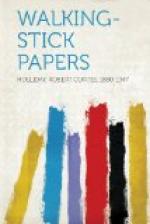The women of this audience frequently are rather dowdy, and shapen in very individual fashions. The men generally are elderly beings, now and then reminiscent of the period of Horace Greeley. They are very bald, or with untrimmed white (not grey) hair, and, sometimes, Uncle-Sam-like whiskers. They are usually very wrinkled as to trowsers and overcoats. Here and there among the gentlemen of this company is to be seen one who looks strikingly like Emile Zola, or the late Mr. Pierpont Morgan slightly gone to seed. All these charming folk make of looking at old-fashioned pictures a very busy occupation, and also in effect a rather mundane occupation, as though they were alertly considering the possibility of making a selection from among a variety of serviceable kitchen chairs.
Argumenting the throng are authentic representatives of the world of fashion; some who appear to be students; the ever present foreigners, including the frequently present Jap; a number of those enigmatic beings who continually take notes at art exhibitions; and a respectable quota of those ladies we always have with us at art exhibitions who in the presence of pictures and it necessary to say: “Isn’t that wonderful, marvellous tone quality!” Occasionally a decidedly quaint student of Art strolls in, past the imposing flunky (in finery a bit faded) at the door, strolls in in the form of a lodger in Madison Square. He looks at the pictures as if thoughtfully, but without animation.
Well, we have now covered, in an elementary way, about every important species of art show, except one, the most human perhaps of all, that held annually on Fifty-seventh Street. We should hardly have time to go up there to-day. I’ll tell you about it. There are several reasons why this exhibition is the most human perhaps of all. One is that more people go than to any other. And these people, taken by and large, are more human, too, than one sees at most art exhibitions, that is more like just ordinary people. This may be, for one thing, because the pictures as a rule are more ordinary pictures. And a very human touch, indeed, is this: when you see the card “Sold” on a painting it is fairly certain to be one of the most ordinary pictures of the lot.
That reminds one of museums. People who are called in the world to the curious pursuit of copying pictures in museums, for some reason or other which I have been unable as yet to work out, apparently always copy the most bourgeois pictures there. But museums, with their throngs of subdued holiday makers and their crowds of weary gaping aliens of the submerged order, museums comprise a separate study.
At any rate, I hope in our stroll I have been able to give you a new insight into the fascination of the great world of Art.
IV
A ROUNDABOUT PAPER




